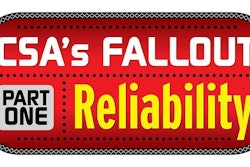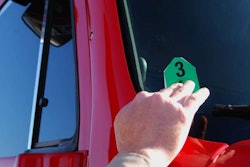 “We lost our triangle, and it is incredible how much difference it has made. Many of our old customers told me they checked every month to see of they could use us again, and called as soon as we lost the triangle.” –small fleet owner J. Webb Kline on shedding his fleet’s Hours BASIC score under CSA
“We lost our triangle, and it is incredible how much difference it has made. Many of our old customers told me they checked every month to see of they could use us again, and called as soon as we lost the triangle.” –small fleet owner J. Webb Kline on shedding his fleet’s Hours BASIC score under CSAYou’ll recall the case of J. Webb Kline’s Cream of the Crop Transportation, whose voice was prime in this story presenting a growing chorus of small carriers in their case against the public use of the Compliance Safety Accountability Safety Measurement System. His story of an Hours of Service Behavior Analysis and Safety Improvement Category (BASIC) score well beyond the intervention threshold and its deleterious effect on a good portion of his business was repeated during my reporting in the CSA’s Data Trail series through May, and Kline wasn’t the only small fleet rep or owner-operator sharing such scenarios.
Today, I’m happy to report, he’s got further evidence for federal officials showing real-world CSA impacts — this time around its business positive.
Kline lost business with his negative Hours BASIC score, as you’ll recall — as much as $1.5 million worth in annual sales, he’d estimated — but now that he’s not had a violation in the Hours BASIC for more than a year since the two that put his carrier over the threshold there, his small fleet no longer shows any percentile ranking or score whatsoever in the BASIC.
“We lost our triangle,” he says, referring to the “warning” symbol FMCSA utilizes to indicate a carrier is above the intervention threshold in a BASIC, “and it is incredible how much difference it has made. Many of our old customers told me they checked every month to see of they could use us again, and called as soon as we lost the triangle. Our sales shot up from an average of $4,000 a week per truck to well over $5,000, and often exceeding $6,000 per week per truck practically overnight.”

While it’s “great news for all of us,” Kline says, it’s also a “a glaring example of just what an economic disaster this program is for companies like ours who fall through the cracks of the system. It’s bad enough if it was deserved, but when undeserved, it really sucks.”
Keep in mind, without a single hours violation for a full year, before the May 24 update Kline’s fleet still had “its triangle” marking it as deficient, with a score of 75, above the Hours BASIC’s intervention threshold of 65. Again, it seems virtually impossible for small fleets to show anything but a very negative score in the CSA SMS — a real problem with the system when it comes to score management. At least in Kline’s case his shippers don’t require him to actually show a score, a phenomenon that is a reality in some quarters. For more on scoring dynamics and shipper/broker use of scores in carrier selection, see this installment in the CSA’s Data Trail series.
And if you missed the news from over the weekend, Panther Expedited Services’ Irwin Shires noted oral arguments in the CSA lawsuit brought by the ASECTT coalition over some of these very issues will get underway in September. Here’s hoping the suit results in resolution to the problems — perhaps going as far as getting “this system removed from public view,” as Shires noted. Find the story about his presentation attendant to the Expedite Expo show here.













